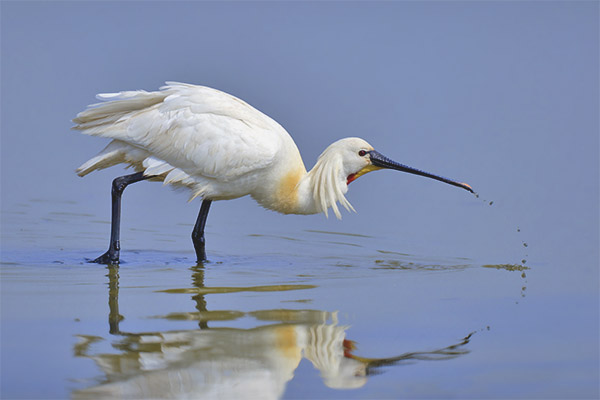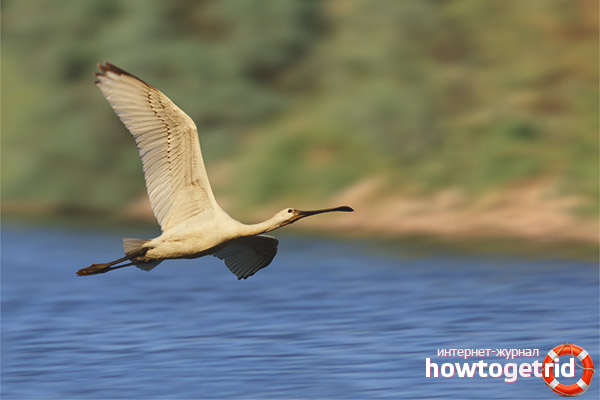The content of the article
This large bird is often mistaken for a stork or a heron. It belongs to the family of birds of the order of the ciconiiformes and belongs to the spoonbone subfamily. It's about the common spoonbill. Her body reaches one meter in length, its weight is from one to two kilograms, and its wingspan varies from 1.15 to 1.35 m. The dense, dense plumage in most cases is snow-white, and the surfaces of the beak and legs are black. In the period of mating games, long tufts stand on the heads of males, and there is a red spot on the neck.
Habitat
Spoonbills, living in Europe and Asia, are migratory, and those that nest in North Africa, New Zealand, Australia and New Guinea are not. It is noteworthy that European birds for wintering fly to Africa, and Asian birds to China or India. Birds prefer to live near shallow, oozy reservoirs, near small fresh or salty lakes.There is enough food available for them:
- crustaceans;
- frogs;
- fry;
- worms;
- various water plants;
- small fish;
- midges;
- various insects and their larvae.
They usually huddle in reeds, coastal shrubs or directly on trees.
Features and breeding birds
Usually these birds create small flocks or even join flocks of other birds, for example, herons. The Spoonbill's resemblance to a stork is explained by the fact that in flight she, like him, pulls her long neck forward. In addition, it has long and thin legs with membranes, peculiar to all swamp birds.
The bill of spoonbills is thin and long, but expanding and as if flattened at the end, with a characteristic orange spot at the very tip. The tail is almost invisible, because it is very short and has a wedge shape. There are no external sex differences between the female and the male.
It is worth saying a few more words about plumage. Despite the fact that most individuals wear white feathers, there are among six types of spoonbills and those who are colored differently. The pink spoonbill has a gorgeous bright pink feather colored in gray on the head and neck.This coloring is typical for birds, eating a large number of carotenoids. The bird lives in America, and goes to Chile or Argentina for the winter.
In addition to pink, you can distinguish a red-brown spoon-spoon a loaf. Her pen is mostly black in color with transitions to red-brown tones on the neck and abdomen. The wings are greenish and purple. This bird weighs only 500 grams.
Usually the spoonbills begin hunting in the evening, when it becomes noticeably dark. Once out in the shallow water, they lower their half-opened beaks into the water and begin to “mow down” the fish or insects. They drive back and forth with their beak, as if mowing something in the water. As soon as the fish swims under the beak, the bird instantly closes it, firmly holding the prey. Therefore, the natives are often called the spoonbills "mowers." If there is no water movement in a river or reservoir, then the birds hunt one by one. In small rivers, even with a weak flow of water, they catch prey by a whole flock, lining up and moving towards the flow one after another.
April and July are a fertile time for mating games. They are attended by birds that have reached three years. Males adorn themselves in front of females with tufts and brush their halves feathers.Those, in turn, reciprocate. In addition to reeds, where reed nests are built right on the ground, birds can build them on floating rafts of the same reeds or branches. They are also able to occupy the nests of the copepod. These include:
- pink and curly pelican;
- cormorant.
In the colonies of birds can be counted from 6 to 160 individuals. Sometimes they adjoin flocks of other birds. In the mating season, spoonbills are very aggressive and actively protect their offspring and nests for the slightest reason. The rest of the time, they are quite peaceful and calm.
Usually the female lays from two to five to six eggs. Both partners take part in hatching. The whole process takes up to three to four weeks. Chicks appear in white fluff and with soft beaks. For a while, parents feed them in turn. And the chicks get food right from their esophagus. When the babies are four weeks old, they will be ready for life next to the nest, because just no longer fit into it. They will patiently wait for parents nearby while they hunt. By 49 days, the chicks begin to stand on the wing. By this time, they fully fledge, and their beaks will become strong and similar to the parent. Upon reaching two months, the chicks already grow up so that they can hunt themselves.
Interesting Facts
- Thanks to the rising air masses, birds can migrate over long distances, hovering above the ground on their large wings. During such flights, birds fly one after the other, forming a kind of wedge or Latin letter “V” in the sky.
- Spoonbills look very similar to herons or storks. With the latter, they have not only external resemblance, but also the same footprint on the sand. With the only minor difference that there is a deeper fossa from the back finger of the spoonbill than from the finger of the stork.
- On the beak of a bird, there are many sensitive receptors, with which it senses the slightest movement of prey inside it. As soon as the brain receives a signal of such movement, the bird immediately closes the beak and swallows the victim.
- Due to the extinction and contamination of the bird’s habitat, its numbers are steadily decreasing. Today it is listed in the Red Book.
- Thus, its image can be found on a commemorative coin of Kazakhstan, which is included in the “Red Book of Kazakhstan” series. The spoonbill can also be found on the postage stamp of Azerbaijan.
Video: Spoonbill (Platalea leucorodia)












To send